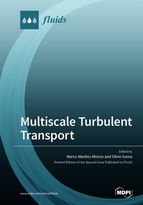Multiscale Turbulent Transport
A special issue of Fluids (ISSN 2311-5521).
Deadline for manuscript submissions: closed (30 June 2019) | Viewed by 36658
Special Issue Editors
Interests: fluid dynamics; turbulence; theoretical, non-linear and statistical physics; transport properties of inertial particles; multiple-scale formalism
Interests: turbulence, magnetohydrodynamics, computational fluid dynamics, econophysics, optimization
Special Issues, Collections and Topics in MDPI journals
Special Issue Information
Dear Colleagues,
Turbulent transport is currently a great subject of ongoing investigation at the interface of methodologies running from theory to numerical simulations and experiments, and covering several spatio-temporal scales. Mathematical analysis, physical modelling and engineering applications represent different facets of a classical, long-standing problem still far from achieving a thorough comprehension. The goal of this Special Issue is to offer recent advances covering subjects identified in the keywords (and not only). Authors are welcome to submit regular articles, review papers focused on the state-of-the-art and the progress made over the last few years, as well as new research trends.
Dr. Marco Martins Afonso
Prof. Sílvio Gama
Guest Editors
Manuscript Submission Information
Manuscripts should be submitted online at www.mdpi.com by registering and logging in to this website. Once you are registered, click here to go to the submission form. Manuscripts can be submitted until the deadline. All submissions that pass pre-check are peer-reviewed. Accepted papers will be published continuously in the journal (as soon as accepted) and will be listed together on the special issue website. Research articles, review articles as well as short communications are invited. For planned papers, a title and short abstract (about 100 words) can be sent to the Editorial Office for announcement on this website.
Submitted manuscripts should not have been published previously, nor be under consideration for publication elsewhere (except conference proceedings papers). All manuscripts are thoroughly refereed through a single-blind peer-review process. A guide for authors and other relevant information for submission of manuscripts is available on the Instructions for Authors page. Fluids is an international peer-reviewed open access monthly journal published by MDPI.
Please visit the Instructions for Authors page before submitting a manuscript. The Article Processing Charge (APC) for publication in this open access journal is 1800 CHF (Swiss Francs). Submitted papers should be well formatted and use good English. Authors may use MDPI's English editing service prior to publication or during author revisions.
Keywords
- Multiscale analysis in turbulent transport processes
- Lagrangian and Eulerian descriptions of turbulence
- Advection of particles and fields in turbulent flows
- Ideal or non-ideal turbulence (unstationary\inhomogeneous\anisotropic\compressible)
- Turbulent flows in bio-fluid mechanics and magnetohydrodynamics
- Control and optimization of turbulent transport






